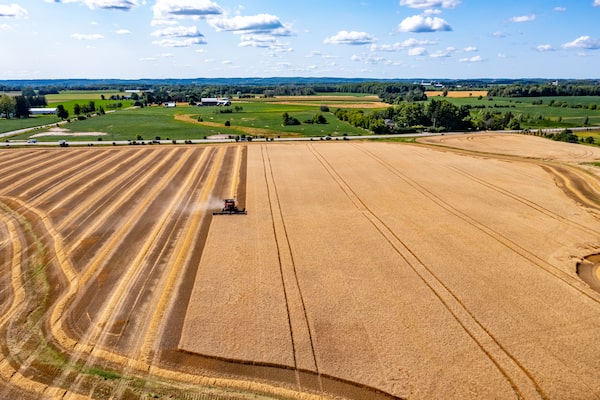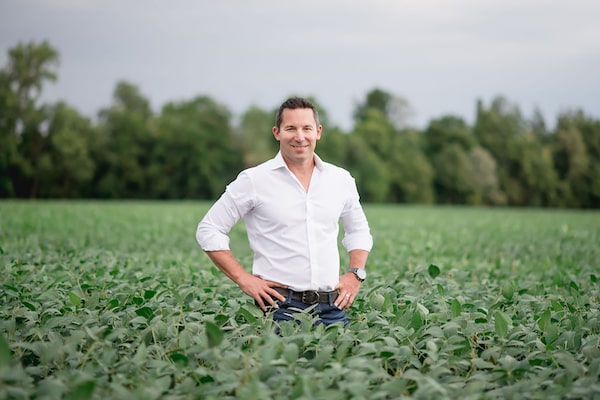
In the past three decades, the average price per acre of Canadian farmland has skyrocketed more than 800 per cent. According to Farm Credit Canada, farmland values rose by approximately 8 per cent in 2023, according to Farm Credit Canada.jimfeng/Getty Images
After 30 consecutive years of growth, Canadian farmland values increased again in 2023 and are forecast to rise in 2024, says an expert at Farm Credit Canada, a Crown corporation that monitors land sales.
“Limited availability of farmland for sale and expanding demand for what we’re growing in Canada” will continue to propel appreciation in 2024, says FCC’s vice-president and chief economist J. P. Gervais.
Farmland values across Canada rose by approximately 8 per cent in 2023, compared with 12.8 per cent in 2022, according to FCC figures.
While next year’s increase may be less robust than in previous years, “we’re still seeing a very positive outlook for the industry,” says Mr. Gervais. “I’m a big believer that the demand for land will be strong going forward.”
In the past three decades, the average price per acre of Canadian farmland has skyrocketed 727 per cent, from $547 to $4,527.
Ontario farmland, Canada’s priciest, soared from $3,248 per acre to $17,962 – though a CBC report pegs the average price closer to $30,000.
Mr. Gervais says farmland unaffordability is at the “worst point” he’s ever seen.
“Farmers buying land must already have land – or an equity base – to be able to make a purchase.”
In southwestern Ontario, analysts agree that it can take 1,000 acres of farmland to support a farm family. This can cost $20- to $30-million to set up from scratch.
A 2020 analysis by the Canadian Centre for Policy Alternatives says “increasing difficulty in gaining access to farmland” has given rise to “concentrated ownership of the land, thus effectively stifling the possibility of farming as a career choice for young Canadians.”
Yet the next generation of farmers isn’t necessarily missing out on opportunities.
In the past 10 years, Mr. Gervais has seen a 15-per-cent increase in the number of non-farmer investors, such as private-equity firms, funding farmland transactions then leasing the land to farmer “partners,” as they’re sometimes called, who otherwise could not afford to be farmers.
Every year, because of technology, we’re able to produce more on the same acre of land. It’s like if you buy a building with five floors and then the next year it has six.
— Kent Willmore, founder and president of AGinvest
More common in the U.S., where non-farmer investors own about 20 per cent of U.S. farmland, agriculture funds are less established in Canada – with under 2 per cent of land owned by non-farmer investors.
Canadian farmland-focused investment firms include AGinvest Farmland Properties of Chatham, Ont., Area One Farms of Toronto, Veripath of Calgary and Ottawa- and Toronto-based Bonnefield. The latter, Canada’s first and largest farm fund manager, has assets of $1-billion under management – a drop in the bucket compared with Canada’s net farmland value of almost $707-billion.
Today, most of these companies’ websites boast fund returns of eight to 14 per cent.
AGinvest, which holds 6,000 acres of Ontario farmland land in its $120-million portfolio, says it has generated returns of approximately 18 per cent since launching its first public fund in 2018.
Key to the firm’s success is “buying well” and then improving farm productivity to grow equity “in every farm we acquire,” says Kent Willmore, founder and president of AGinvest.
The former long-time farmer says, “it’s very early days for this new era of investment in Canadian agriculture.”
Comparing farmland to commercial real estate 30 to 40 years ago, when investor interest was minimal, he says, “we’re in the top of the first inning” for investment potential.

Former farmer Kent Willmore says that by 'buying well' and then improving farm productivity to grow equity 'in every farm we acquire,' AGinvest has generated returns of approximately 18 per cent.AGinvest
Myriad factors drive the fund manager’s passion for the asset. At its root is increasing global demand for agricultural products, including food and fuel, coupled with growing land constraints – dynamics likely to continue to yield returns that have outperformed stock and bond markets since the turn of the century.
“Ontario farmland in particular has several unique advantages,” Mr. Willmore asserts. “The most crucial is access to water. Many other farming regions globally are losing water.”
In addition, Mr. Willmore says only health sciences receives more global investment in research and development than food production. So, even as Canada has lost 8 per cent of its farmland since 2001, innovations in biogenetics, smart machines and big data have increased production levels.
“Every year, because of technology, we’re able to produce more on the same acre of land,” says Mr. Willmore. “It’s like if you buy a building with five floors and then the next year it has six.
“Farmers are able to earn greater revenue per acre because, one, they produce more bushels of corn, and two, because each bushel of corn is worth more.”
Brennan Carson, partner at Oakville, Ont.-based Equate Asset Management, says it’s important his clients know that investing in farmland “isn’t a speculative play” with development of the land the goal.
“This is about farmland for the sake of feeding people.”
Mr. Carson says farmland funds like AGinvest are “filling a gap” created by the farming sector.
“You have this very fragmented market of individual farms that have been held by families for two or three generations. They’ve never monetized, never exited,” he says, adding that there’s a dearth of “natural buyers.”
“Somebody has to fill that void,” he continues.
Mr. Carson says Equate’s 85-client, $250-million portfolio is weighted with conventional real estate and renewable energy assets.
“There’s an underscore of sustainability in ways we invest our client’s money,” he says.
“Farmland fits nicely into that theme,” yet until recently, “it hadn’t been an option” for the company.
In the past couple of years, however, “we have gone from one or two original seed investors to 20 per cent of our clients now exposed to farmland,” he says. “And that number only continues to go up.”
Editor’s note: This article has been updated to correct the stated percentage increase in the average price per acre of Canadian farmland.